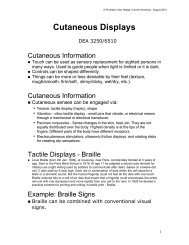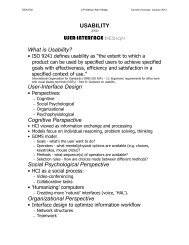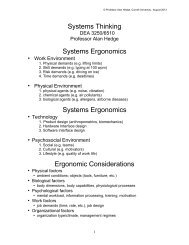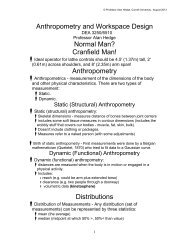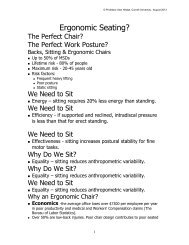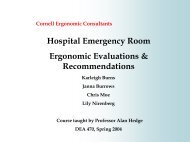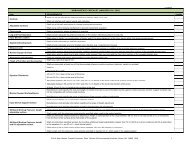Ergonomic Evaluation of Acute Care Nursing - Cornell University ...
Ergonomic Evaluation of Acute Care Nursing - Cornell University ...
Ergonomic Evaluation of Acute Care Nursing - Cornell University ...
You also want an ePaper? Increase the reach of your titles
YUMPU automatically turns print PDFs into web optimized ePapers that Google loves.
<strong>Ergonomic</strong> <strong>Evaluation</strong><strong>Acute</strong> <strong>Care</strong> <strong>Nursing</strong> HealthCenterCaroline HegartyJamie RosenbergRachel SteckerMay 1, 2003DEA470/670 2003, © <strong>Cornell</strong> <strong>University</strong>
Most Injury Inducing Tasks(Owen & Garg, 1990)RESEARCH1. Chair / toilet transfers2. Bed / chair transfers3. Bathtub / chair transfers4. Chairlift / chair transfers5. Weighing the patient6. Lifting the patient up to headboard7. Repositioning patient in bed side to side8. Repositioning in chair9. Changing an absorbent pad10. Making the bed with the patient in it11. Undressing the patient12. Tying supports13. Feeding a bed ridden patient14. Making the bed with the patient not in itDEA470/670 2003, © <strong>Cornell</strong> <strong>University</strong>
<strong>Acute</strong> <strong>Care</strong> UnitNURSES’ BACKGROUND• 26 patients - all ages and conditions• 6 patients per nurse• Average length <strong>of</strong> patient stay is 3-5 days• Majority <strong>of</strong> patients are there for a “tune-up”• 25% <strong>of</strong> day spent doing charting and documentationStaff consists <strong>of</strong>:• Charge nurses• Registered Nurses• Licensed Nurse Practitioners• Certified Nurse AssistantsTraining• Most <strong>of</strong> training is in school not in the workplace• Orientation course for lifting techniques• Yearly updates• Post-injury counseling and trainingDEA470/670 2003, © <strong>Cornell</strong> <strong>University</strong>
A Typical Nurse’s DayNURSES’ BACKGROUND3 Different work shifts:• 8 hour day shifts ie. 7am to 3:30 pm• 12 hour day night shifts ie. 7am to 7pm• 12 hour evening shifts ie. 7pm to 7amDaily ScheduleFirst 2 hours: Arrive and begin patient care, rounds with doctors1 hour: Charting/computer work2 hours: Second round <strong>of</strong> medication, x-rays etc1 hour: Charting/computer work2 hours: Rounds/patient careDEA470/670 2003, © <strong>Cornell</strong> <strong>University</strong>
Most Common InjuriesTOTAL Health Facility Statistics:Total Number <strong>of</strong> Cases with days away from work: 22INJURY ANALYSISTotal Number <strong>of</strong> Days away from work: 489Total Number <strong>of</strong> Cases resulting in job transfers: 5Other cases: 11Total number <strong>of</strong> injuries: 38DEA470/670 2003, © <strong>Cornell</strong> <strong>University</strong>
Most Common InjuriesCNA’s are responsible for bulk <strong>of</strong> physical activity andmost <strong>of</strong>ten injuredInjuries in 2002 by job title:INJURY ANALYSISRN- Bedside--- Hand injurytransferLeft arm strainmissed 1 dayLeft hamstringtransferLower back/sciatic pain missed 1 dayNurse Assistants--- Left shoulder pain transferBack injurymissed 2 daysRadiology Nurse--- Fall onto knees missed daysLPN (meds nurse)--- Low back painmissed days<strong>Acute</strong> nursing care had much fewer injuries than other FLH units.DEA470/670 2003, © <strong>Cornell</strong> <strong>University</strong>
Tasks we looked at:ERGONOMIC EVALUATION• Sitting and standing at computerworkstation• Pushing medication cart• Transferring patients to chairs• Changing IV bags• Using lift equipment• Pushing wheelchairs• Transferring patients to and from beds• Sliding patients to headboard• Carrying trays and assistance with eating• Help with dressing• Transferring patients on stretchersDEA470/670 2003, © <strong>Cornell</strong> <strong>University</strong>
ERGONOMIC EVALUATIONStanding at computer workstationREBA evaluation:Trunk: 1Neck: 2Legs: 1Upper Arms: 1Lower Arms: 2Wrist: 2A: 1B: 2Load/Force Coupling: 0C: 1Activity: 1REBA: 2Action Level: 1- Action may be necessaryDEA470/670 2003, © <strong>Cornell</strong> <strong>University</strong>
ERGONOMIC EVALUATIONSliding patient to headboardREBA evaluation:Trunk: 3Neck: 1Legs: 2Upper Arms: 2Lower Arms: 2Wrist: 2Force: 3A: 7Coupling: 3B: 6C: 9Activity: 1REBA: 10Action Level: 3- Necessary to take action soonDEA470/670 2003, © <strong>Cornell</strong> <strong>University</strong>
ERGONOMIC EVALUATIONChanging IV BagREBA evaluation:Trunk: 2Neck: 2Legs: 1Upper Arms: 5Lower Arms: 2Wrist: 1Force: 0A: 3Coupling: 3B: 10C: 8Activity: 1REBA: 9Must do multipletimes a day forevery patientAction Level: 3- Necessary to take action soonDEA470/670 2003, © <strong>Cornell</strong> <strong>University</strong>
Computer Workstations• Workstation design is sufficient• Change to downward sloping keyboards• Offer training in proper and safe computer use• A great amount <strong>of</strong> force is needed to adjust height -change to an easier grip and reduce resistanceSUGGESTIONSDEA470/670 2003, © <strong>Cornell</strong> <strong>University</strong>
Sliding patient to headboardSUGGESTIONSOptions:• “Conveyer belt” sheet that cycles around the bedby pressing a button or using a crank• Install handles on existing sheets• Use same system but step to head <strong>of</strong> bed instead<strong>of</strong> swinging body• Hold person and lift to headboard instead <strong>of</strong> usingthe sheet and personMost important changeis to have a better gripDEA470/670 2003, © <strong>Cornell</strong> <strong>University</strong>
Changing IV BagOptions:• Have a chair-like foot pump to raise and lower theheight <strong>of</strong> the IV bag• Install an up and down button for adjusting heightSUGGESTIONSThe current stands are height adjustable, but it takestoo long and requires too much effort. A simpler, easiersystem would encourage proper use and reduceinjuries.DEA470/670 2003, © <strong>Cornell</strong> <strong>University</strong>
A few more suggestions…CONCLUSIONS• Emphasize importance <strong>of</strong> properly using equipment• Mechanical changes are easy but staff behaviorsmust be changed in order to really reduce thenumber and severity <strong>of</strong> injuries• Offer more, mandatory training• Create a reward system for attending trainingsessions and using techniques learned• Have random evaluations <strong>of</strong> techniquesIn general, the current situation is acceptable. The lowstaff to patient ratio and higher level <strong>of</strong> physical andmental functioning <strong>of</strong> the patients makes the tasks lessstrenuous.DEA470/670 2003, © <strong>Cornell</strong> <strong>University</strong>



